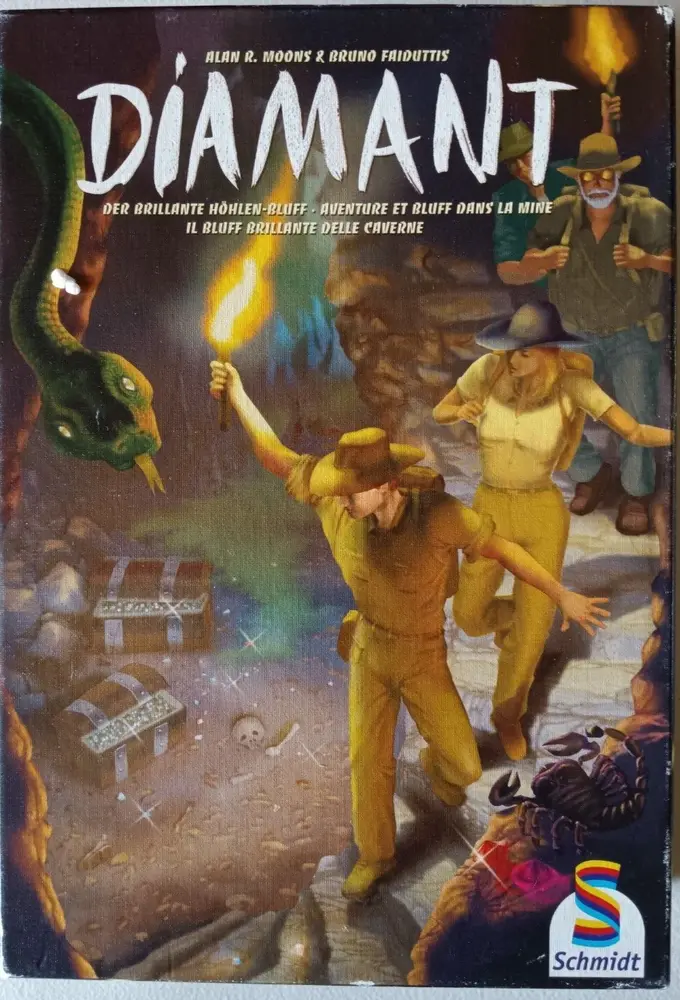Diamant (1975)
Brief History and Background Information of Diamant
Diamant is a multiplayer card game designed by Alan R. Moon and Bruno Faidutti, published in 2005 in Germany by Schmidt Spiele, with illustrations provided by Jörg Asselborn, Christof Tisch, and Claus Stephan. An English-language edition of Diamant was published in 2006, by Sunriver Games under the name Incan Gold, with illustrations provided by Matthias Catrein. The rules for Incan Gold and Diamant are the same, but the games have other minor differences. The game was inspired by the game Can’t Stop by Sid Sackson, which both designers held in great esteem. They wanted to design their own game where players would have to choose between keeping what they have or risk losing all they had acquired. Faidutti suggested a kind of “common pool Can’t Stop” where all the players were in the same situation but could make different decisions.
Why is Diamant Popular?
Diamant has been nominated for several awards, including the International Gamers Awards 2005 Best Strategy Game Nominee, the Japan Boardgame Prize 2005 Best Foreign Game for Beginners, and the 2006 BoardGameGeek Golden Geek award for Best Party Board Game. The game is popular because it is easy to learn and play, and it is suitable for a wide range of ages and skill levels. It is also a quick game, with a typical playtime of around 30 minutes.
Game Components of Diamant
– 1 rulebook
– 1 game board
– 5 sets of explorer cards (in 5 different colors)
– 1 deck of expedition cards
– 1 deck of hazard cards
– 1 deck of treasure cards
– 1 deck of artifact cards
– 1 deck of diamond cards
– 1 deck of camp cards
– 1 deck of exit cards
– 1 deck of bonus cards
– 1 start player marker
– 1 exit marker
– 1 diamond marker
– 1 camp marker
– 1 score pad
– 1 pencil
Game Setup of Diamant
Place the game board in the center of the table.Shuffle the deck of expedition cards and place it face down on the board.Shuffle the deck of hazard cards and place it face down on the board.Shuffle the deck of treasure cards and place it face down on the board.Shuffle the deck of artifact cards and place it face down on the board.Shuffle the deck of diamond cards and place it face down on the board.Shuffle the deck of camp cards and place it face down on the board.Shuffle the deck of exit cards and place it face down on the board.Shuffle the deck of bonus cards and place it face down on the board.Each player chooses a color and takes the corresponding set of explorer cards.The start player marker is placed on the board.The exit marker, diamond marker, and camp marker are placed on the board.The score pad and pencil are placed near the board.
Gameplay Mechanics of Diamant
Players take turns revealing cards from the expedition deck. Each card represents a step deeper into a cave, and players must decide whether to continue or return to camp. If a hazard card is revealed, players who decided to continue lose all the treasure they have collected during that expedition. If a diamond card is revealed, players who decided to continue collect a diamond. If an exit card is revealed, players who decided to continue must return to camp, and players who decided to return to camp collect all the treasure they have collected during that expedition. Players can also play artifact cards to protect themselves from hazards or to collect extra treasure. The game ends when the last card from the expedition deck is revealed, or when all players have returned to camp. The player with the most treasure at the end of the game wins.
Game Objective of Diamant
The objective of Diamant is to collect the most treasure by exploring a cave and avoiding hazards.
Player Experience
Diamant is a fun and exciting game that is easy to learn and play. Players must decide whether to continue exploring or return to camp, and they must weigh the potential rewards against the risks of encountering hazards. The game is fast-paced and unpredictable, with players never knowing what cards will be revealed next. The game is suitable for a wide range of ages and skill levels, and it can be played with 3 to 8 players.
Game Components of Diamant
How To Setup Diamant
To set up *Diamant*, players start by shuffling the tunnel tile deck. Each player chooses a token to mark their progress. The game is divided into five rounds, each representing a different tunnel. At the beginning of each round, players enter the tunnel and draw tiles from the deck, revealing treasures, artifacts, or traps.
Gameplay Mechanics and Game Objective
Player Experience
*Diamant* offers a thrilling and tense experience as players balance risk and reward. The game starts light and fluffy but quickly becomes intense as players try to outmaneuver each other. Table talk is common as players try to psych each other out, adding a social and strategic layer to the game. It is quick to learn and play, making it accessible to a wide range of ages.
Pros
Cons
Personal Thoughts on Diamant
*Diamant* is perfect for those who enjoy push-your-luck games and are looking for a quick, engaging experience. It is an excellent family game due to its simplicity and short playtime, yet it also appeals to experienced gamers who enjoy strategic decision-making. The game’s ability to tell a story, especially with its Indiana Jones-liketheme, adds to its charm and makes it a great addition to any game collection.
We are supported by our audience. When you purchase through links on our site, we may earn an affiliate commission, at no extra cost for you. Learn more.

